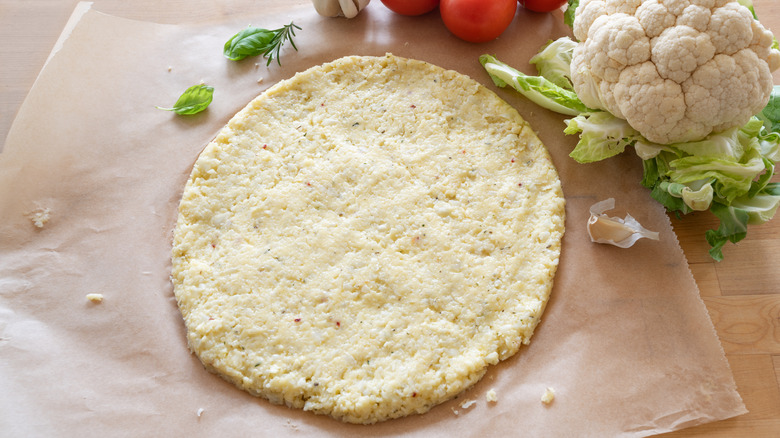The Crucial Step For Making Sure Your Cauliflower Pizza Crust Is Perfectly Crispy
Cauliflower pizza crust is awesome if you're craving a gluten-free slice of cheesy heaven. However, this dreamy vegetarian base can miss the mark if it doesn't crisp up to perfection in the oven like its classic floury counterpart. Fortunately, there's a simple way to guarantee that your next cauli pizza crust has a crisp, moreish texture — wring out the excess water from the cooked shreds before adding in your binders and baking.
Packed full of fiber and antioxidants, the flavor of a cauliflower pizza crust is delicious when paired with a herby marinara sauce and melty cheese. However, its texture must also be sturdy enough to hold all these toppings without breaking apart into chunks or disintegrating completely when you lift a slice off the plate. For your cauli crust to truly mimic the structural qualities of a traditional base, you need to eliminate as much moisture as possible from the cooked shreds.
Cauliflower can become mushy and saturated with liquid when boiled, which explains why cooking riced cauli in water isn't recommended if you want to retain its toothsome texture. Nevertheless, this technique is ideal for making a pizza base (as long as you remove the grains from the pan before they overcook) because you'll be shaping the shredded vegetable into a pliable dough rather than serving it as an alternative to rice. Luckily, preparing a homemade cauliflower crust is simple and means you won't have to rely on store-bought gluten-free pizza.
How to squeeze liquid out of cooked cauliflower
Place your cooked (preferably microwaved) cauliflower in the center of a clean tea towel (or a piece of cheesecloth if you have it). Pull the sides of the cloth up so the shreds are encased into a little bag and spin it to create a twist where the cauli meets the fabric. Hold the bag over the sink and squeeze it to allow any moisture inside to drip into the basin.
Another option is to put the bag in a colander that's been set in the sink before placing a heavy object on top, like a large dish or can, in the same way as you'd drain homemade ricotta cheese. This method is particularly useful because you can leave the cauliflower to drain unattended as you prep the other elements of your pizza, such as the sauce and toppings.
Finally, add the rest of your ingredients, like eggs and shredded cheese, to your drained cauliflower to make the pizza crust come together. The moisture from the egg will be just enough to bind the dough without making it soggy and tricky to handle. Shape your dough into a circle and bake until crispy. If you like a super-crispy crust, flip the base over and roast the other side for a few extra minutes.

